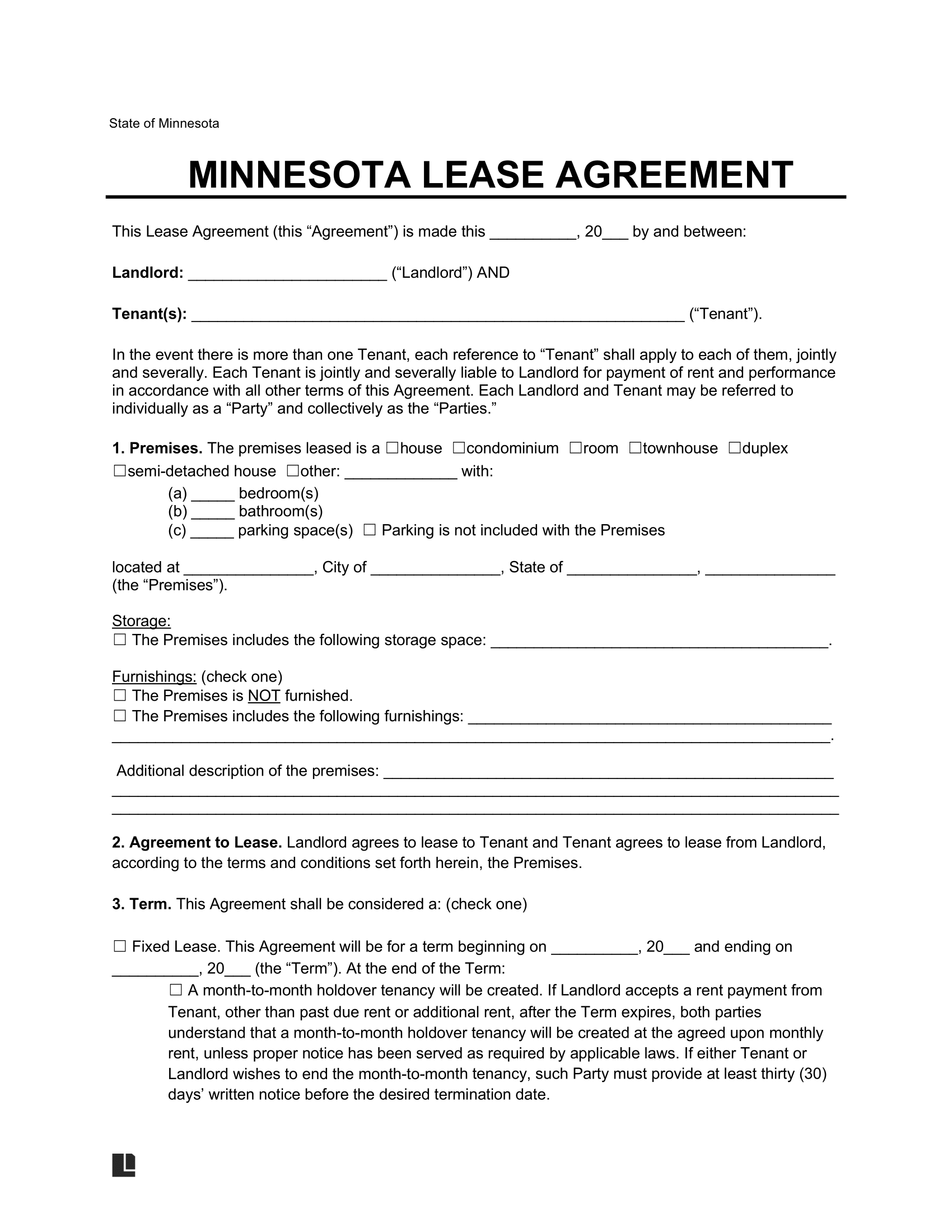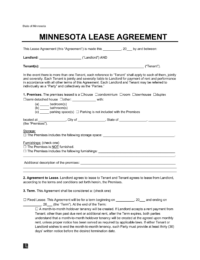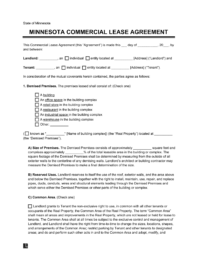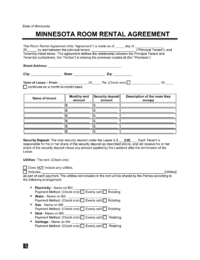A Minnesota lease agreement is a legally binding document that outlines the terms of a lease that a property owner and tenant agree to. Federal and state law mandate that the documents include specific details, such as the information of both parties, address and condition of the premises, lease term, rent due dates, payment methods, warnings and disclosures about any hazards, late fees, and grace periods.
Familiarizing yourself with Minnesota’s specific rental guidelines will help protect your legal and financial rights.
Rental Lease Laws Overview
- Rent Control: No, but cities like St. Paul have a rent control ordinance.
- Limit on Late Fees: Yes.
- Late Fees in Rental Agreement: Yes.
- Grace Period: No.
- License Required for Landlord: No, but certain cities might require one.
By Type (6)
Standard Lease Agreement
Use to form a rental agreement between a landlord and a tenant for residential property.
Month-to-Month Rental Agreement
Offers residents the chance to enjoy flexible month-to-month living arrangements, free from the obligation of a long-term commitment.
Commercial Lease Agreement
Creates a landlord-tenant relationship for the lease of a commercial property.
Room Rental Agreement
Establish a structured living arrangement by creating a legally binding agreement involving the primary occupant and other cohabitants.
Sublease Agreement
Creates an official arrangement between the primary tenant (sublessor) and the sublessee, allowing the latter to temporarily inhabit the rental property with the clear approval of the landlord.
Rent-to-Own Lease Agreement
Enables a tenant to lease a property and receive the option to buy it when the rental period ends.
Required Lease Disclosures
State law imposes certain requirements for landlords and tenants that need to be included in the lease agreement [1] :
- Identification. Landlords must specify the person authorized to manage the premises along with an address to send notices [2] .
- Notice of Foreclosure. Minnesota landlords must deliver written notice disclosing the fact that the residential property has entered the foreclosure process [3] .
- Covenant of Landlord and Tenant Not to Allow Unlawful Activities. The lease agreement must include the following words [4] :
“Landlord and tenant promise that neither will unlawfully allow within the premises, common areas, or curtilage of the premises (property boundaries): controlled substances, prostitution or prostitution-related activity; stolen property or property obtained by robbery; or an act of domestic violence, as defined by MN Statute Section 504B.206 (1)(e), against a tenant, licensee, or any authorized occupant. They further promise that the aforementioned areas will not be used by themselves or anyone acting under their control to manufacture, sell, give away, barter, deliver, exchange, distribute, purchase, or possess a controlled substance in violation of any criminal provision of chapter 152.”
- Outstanding Inspection Orders. Required when there are outstanding inspection and condemnation orders for the premises [5] .
- Lead-Paint Disclosure. The Environmental Protection Agency (EPA) holds Minnesota landlords of any building constructed before 1978 responsible for notifying all tenants of the potential existence of lead-based paint hazards.
Security Deposit
- Maximum Amount: Minnesota state law does not establish a maximum amount for security deposits.
- Receipts: Landlords must provide tenants with a receipt for the security deposit upon payment [6] .
- Interest Payments: Landlords must hold the security deposit in an account bearing simple non-compounded interest at a rate of 1% per annum [7] .
- Bank Account: Security deposits do not need to be kept in separate accounts but must accrue interest as specified.
- Returning Requirements: The landlord must return the security deposit, with interest, within three weeks of the termination of tenancy [7] .
- Withholding Rules: If any portion of the security deposit is withheld, the landlord must provide a written statement outlining the specific reason for the withholding [7] .
Rent Payments
- Laws: Rent is due on the date specified in the lease agreement.
- Rent Control: There is no statewide rent control in Minnesota.
- Late Fees and Grace Period: Late fees must be established in the lease agreement and may not exceed 8% of the monthly rent [8] . There is no statutory grace period for paying rent.
- Withholding Rent: Tenants may withhold rent and deposit it with a court administrator if there is a need for repairs and the landlord has been given written notice [9] .
Landlord Right of Entry
- Notice Requirements:
- Landlords must give 24-hours’ notice before entering the property, specifying a time and window of entry between 8:00 a.m. and 8:00 p.m., unless otherwise agreed [10] .
- Landlords may enter without notice if they believe immediate entry is necessary to prevent injury, determine tenant safety, or comply with local ordinances regarding unlawful activity [10] .
- Keys, Locks, and Security: Landlords cannot lock out tenants without a court order. Tenants may hold the landlord liable for illegal lockouts.
Property Repairs
- Landlord Responsibilities: Landlords must maintain the property in a fit and habitable condition and make necessary repairs within 14 days of receiving written notice from tenants [11] .
- Tenant Repairs: If a landlord fails to make necessary repairs within 14 days, tenants may bring action against the landlord, and the court may order the tenant to fix the violation and deduct the cost from the rent [9] .
- Abandonment: When a tenant abandons a rental property, the landlord can take possession of the property, store the tenant’s belongings, and may sell them after 28 days to cover costs, returning any extra proceeds to the tenant. [12] .
Terminating a Lease
- Month-to-Month Tenancy: Landlords must give at least one month’s notice to terminate a month-to-month lease [13] .
- Unclaimed Property: Any belongings left by the tenant may be claimed by the landlord 28 days after giving notice [12] .
Cold Weather Notice
- Between November 15th and April 15th, Minnesota tenants must provide a landlord with at least three days’ notice before abandoning or permanently vacating the premises (§ 504B.155).
Sample
Below is a free Minnesota lease agreement template you can download in PDF or Word format.






